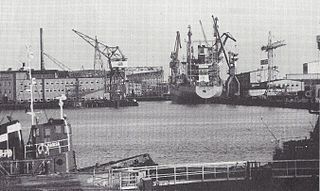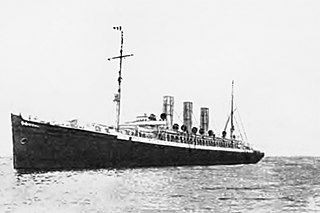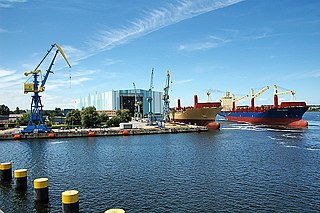
Aktien-Gesellschaft "Weser" was one of the major German shipbuilding companies, located at the Weser River in Bremen. Founded in 1872 it was finally closed in 1983. All together, A.G. „Weser" built about 1,400 ships of different types, including many warships. A.G. „Weser" was the leading company in the Deutsche Schiff- und Maschinenbau AG, a cooperation of eight German shipbuilding companies between 1926 and 1945.
Weser Flugzeugbau GmbH, known as Weserflug, was an aircraft manufacturing company in Germany.
Norddeutscher Lloyd was a German shipping company. It was founded by Hermann Henrich Meier and Eduard Crüsemann in Bremen on 20 February 1857. It developed into one of the most important German shipping companies of the late 19th and early 20th centuries, and was instrumental in the economic development of Bremen and Bremerhaven. On 1 September 1970, the company merged with Hamburg America Line (HAPAG) to form Hapag-Lloyd AG.
Aktien-Gesellschaft Vulcan Stettin was a German shipbuilding and locomotive building company. Founded in 1851, it was located near the former eastern German city of Stettin, today Polish Szczecin. Because of the limited facilities in Stettin, in 1907 an additional yard was built in Hamburg. The now named Vulcan-Werke Hamburg und Stettin Actiengesellschaft constructed some of the most famous civilian German ships and it played a significant role in both World Wars, building warships for the Kaiserliche Marine and the Kriegsmarine later.

Vegesack is a northern district of Bremen, the capital of the German state Free Hanseatic City of Bremen.

Bremer Vulkan AG was a prominent German shipbuilding company located at the Weser river in Bremen-Vegesack. It was founded in 1893 and closed in 1997 because of financial problems and mismanagement.

Schichau Seebeckwerft was a German shipbuilding company, headquartered in Bremerhaven. The name comes from the 1988 merger of Schichau with Seebeckwerft.

The Valentin submarine factory is a protective shelter on the Weser River at the Bremen suburb of Rekum, built to protect German U-boats during World War II. The factory was under construction from 1943 to March 1945 using forced labour, but was damaged by air-raids and unfinished by the end of the war. The Valentin factory was the largest fortified U-boat facility in Germany, and was second only to those built at Brest in France.
Seebeckwerft A.G. was a German shipbuilding company, located in Bremerhaven at the mouth of the river Weser. Founded in 1876, it became later one of the leading shipbuilding companies in the region.

The Bombing of Bremen in World War II by the British Royal Air Force (RAF) and US Eighth Air Force involved both indiscriminate "area bombing" and, as capacity improved, more targeted raids upon the city's military-industrial facilities. These included the shipyards of Vulkan, AG Weser and Atlas Werke, the Valentin submarine pens, oil refineries and the aircraft works of Focke-Wulf.

The Schichau-Werke was a German engineering works and shipyard based in Elbing, Germany on the Frisches Haff of then-East Prussia. It also had a subsidiary shipyard in nearby Danzig. Due to the Soviet conquest of eastern Germany, Schichau moved to Bremerhaven in March 1945, and its successors continued in business until 2009.

Ural was an auxiliary cruiser of the Imperial Russian Navy during the Russo-Japanese War. She was originally a Rivers-class ocean liner for Norddeutscher Lloyd, launched in 1890 under the name Spree. She was renamed Kaiserin Maria Theresia in 1899, before being sold to the Russians in 1904.

Meyer Wismar is a German shipbuilding company, headquartered in Wismar. After June 1, 1990 it was part of the Deutschen Maschinen- und Schiffbau AG, from 2009 it was part of the Nordic Yards Holding GmbH, and in 2016 it became part of the Lloyd Werft Group. In June 2022 Thyssenkrupp Marine Systems (TKMS) acquired the Wismar site of MV Werften. In November 2022, a lease agreement was signed with Meyer Werft to complete the Global Dream with the yard renamed Meyer Wismar.

SS Lichtenfels was an early example of a modern heavy-lift ship. She was launched in 1929 in Germany for DDG Hansa. She was equipped with a 120 t boom crane capable of lifting fully assembled railway locomotives, which were shipped to India.
Several steamships have borne the name Main:
Joh. C. Tecklenborg was a German shipbuilding company, located at the river Geeste in Bremerhaven. About 440 ships of different types, including many famous tall sailing ships were built at the yard. Founded in 1841, it was finally closed in 1928.

SMS V191 was a S-138-class large torpedo boat of the Imperial German Navy. She was built by the AG Vulcan shipyard at Stettin between 1910 and 1911 and launched on 2 June 1911.

The German torpedo boat T21 was one of nine Type 37 torpedo boats built for the Kriegsmarine during World War II. Completed in mid-1942, she was transferred to Norway in March 1943 for escort duties. The ship returned to Germany in October and was assigned to the Torpedo School. T21 returned to active duty in May 1944 and supported German forces operating in the Baltic Sea. The boat began a major refit in December which had not been completed when the war ended in May 1945. She was allocated to the United States after the war, but was only used to dispose of gas munitions by scuttling her in deep water in 1946.
SMS S13 was a V1-class torpedo boat of the Imperial German Navy. The ship was built by Schichau-Werke, at their Elbing shipyard, completing in 1912. She served in the First World War with the German High Seas Fleet, taking part in the Battle of the Heligoland Bight in 1914. She was sunk by an accidental explosion on 6 November 1914.












